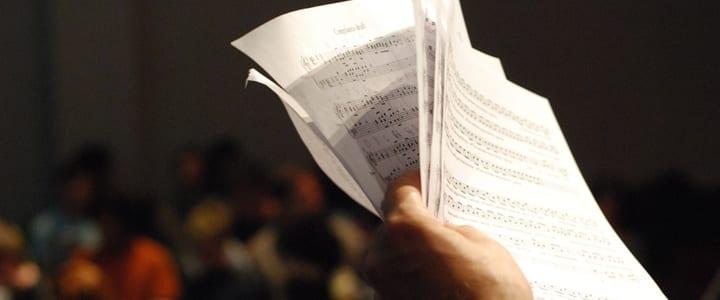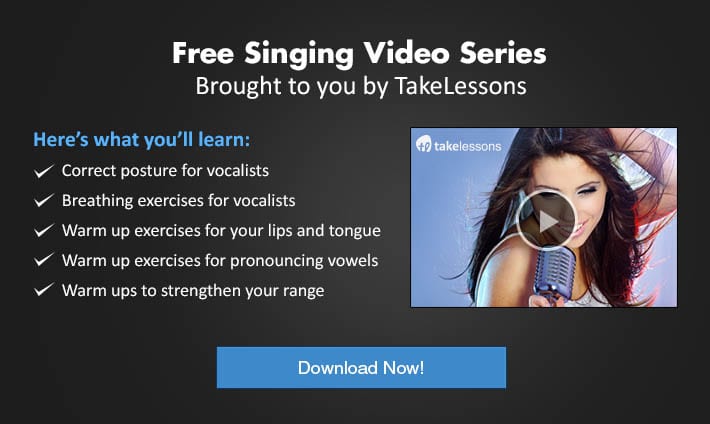Learning to read music can be a daunting task for beginner singers! Here, Ann Arbor, MI voice teacher Elaina R. shows you how to get started…
Not to point out the obvious, but as singers, we don’t have keys on our instrument. We don’t have buttons that emit the same pitch every time they are pressed. Most of us don’t have perfect pitch, either. This makes learning to read music quite different for singers than for other musicians.
Not only do singers deal with learning how to read what is on the page, we have to learn how each note feels in our voice. We have to learn to mentally map intervals and translate them from the page to our instruments. We have to stay in tune, even when singing a cappella (not an easy feat!).
But don’t despair! Learning to read music is easy if you separate out the two basic components that make up music: rhythms and pitches.
Feel the Beat
Drums or clapping can keep rhythm because rhythm is independent from pitch. This is helpful, since you can practice the rhythm of a song before you sing a note simply by clapping or speaking it. If you do this work in advance, you don’t have to deal with learning the pitches and the rhythms simultaneously.
Rhythm is controlled by several elements on the page:
• Time Signatures: The time signature usually consists of two numbers, one stacked on top of the other, that come before the first note in a song. The one on top signifies how many beats are in a measure, while the one on the bottom signifies which note gets one beat. For example, 4/4 fits four quarter notes into each measure, 2/4 fits two quarter notes into each measure, and 2/2 fits two half notes into each measure.
• Notes and Rests: Notes have different durations depending on how they look. They can look like round holes (a whole note, go figure), a filled-in note with a stem attached (a quarter note), a note connected to a bunch of other notes by a single line (an eight note), etc. Rests also have durations. Learning note and rest duration helps you with the rhythm of the music.
Once you’ve familiarized yourself with the different kinds of notes, rests, and time signatures, try to put it all together. Start by speaking or clapping with the time signature. For example, for a piece in 4/4, start by marking time in four (one, two, three, four, one, two, three, four, etc.) Then add the notes and rests into the structure of the time signature.
The Keyboard is Your Best Friend
Once you’ve learned the rhythm to your song, you will need to know a little more musical theory to read the pitches. The basic gist of it is simple: the staff is made up of five lines and four spaces. Each line or space represents a specific pitch. A note placed in a particular line or space means that you have to sing that pitch.
Here are some need-to-know terms for reading pitches:
• Treble and Bass Clef: These determine which line and space corresponds to which note. Treble clef is generally used for higher voices, bass clef for lower voices.
• Sharps and Flats: Sharps raise the notated pitch by a half step, while flats lower it by a half step. To illustrate, if there is a note on the lowest line of a treble clef staff, it is an E. Stick a sharp sign next to it and it becomes E sharp. A flat sign changes it into E flat.
As I’ve already pointed out, singers are at somewhat of a disadvantage as compared to musicians with instruments that aren’t body parts. We can’t press a key and expect to hear the same note every time. Therefore, we can’t pick up a piece of music and read it perfectly without a starting pitch.
This is why, for singers, the keyboard is the best tool for learning to read music. Learn your pitches at the keyboard, listening to each one and repeating it in the context of the rhythm of a song.
Learning to Read, Learning to Sing
Of course, it’s important to reinforce learning to read music with learning to sing it. A voice teacher can help you hit those high notes easily and comfortably, create nice phrases, and breathe in the right places. And if you get stuck trying to read the music, your voice teacher is there to help you learn the notes!
 Elaina R. teaches opera voice and singing in Ann Arbor, MI, as well as through online lessons. She is currently working on a Master of Music at the University of Michigan, and she has a B.M. from the University of Southern California. Learn more about Elaina here!
Elaina R. teaches opera voice and singing in Ann Arbor, MI, as well as through online lessons. She is currently working on a Master of Music at the University of Michigan, and she has a B.M. from the University of Southern California. Learn more about Elaina here!
Photo by Jennifer Brandel
Suzy S.

